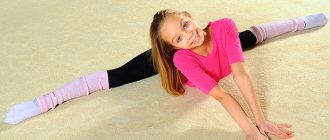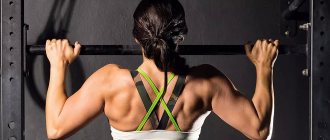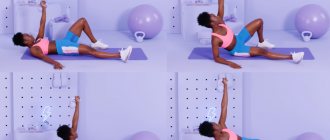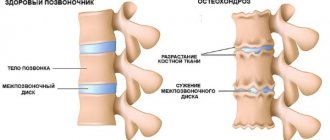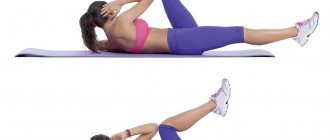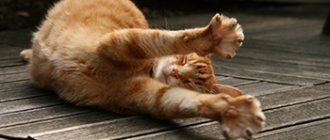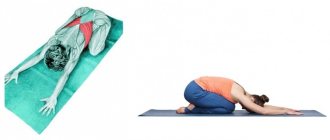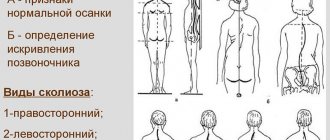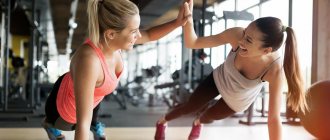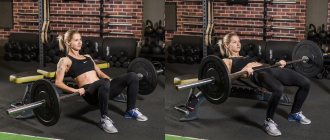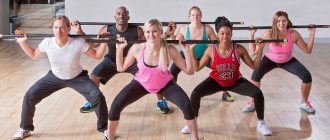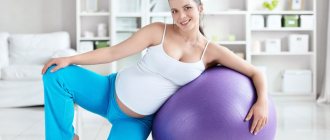December 23, 2011
The simplest and cheapest home exercise machine is a gymnastic stick. Even a mop is suitable for practicing.
The simplest and cheapest home exercise machine is an ordinary gymnastic stick, undeservedly forgotten against the backdrop of modern high-tech exercise equipment. Even a mop handle can be used as such a sports equipment. Nothing could be more accessible. Marina Makarova, head of the exercise therapy department of the Center for Restorative Medicine and Rehabilitation of the Treatment and Rehabilitation Center of the Ministry of Health and Social Development of Russia, talks about how to train with the help of a gymnastic stick.
Selecting a projectile
The standard length of a gymnastic stick is 120 cm
.
Any diameter will suit. The main thing is that you can completely wrap your fingers around it
.
The best option is a narrow stalk, which is made from beech
.
Softwood sticks are less smooth and can cause splinters. handle from modern mops
with a removable head
will also work Don't forget to unscrew it before class. Regular shovel or rake handles
that are sold in hardware stores most likely will not suit you. They are too wide and heavy. In addition, they are uncomfortable to hold in your hand. However, trained men can experiment with such equipment.
Text of the book “Recreational gymnastics for children 3-7 years old. Health-improving gymnastics complexes"
October
Complex 5
1. Walking in a column one at a time with high knees, like cockerels, transition to normal walking; running at a moderate pace, walking.
Exercises without objects
2. I. p. – basic stance, hands on the belt. 1 – step forward with your right foot, hands behind your head; 2 – starting position. The same with the left foot (6 times).
3. I. p. – stand with legs apart, hands on the belt. 1 – tilt to the right (left); 2 – starting position (6 times).
4. I. p. – basic stance, hands on the belt. 1–2 – sit down, arms forward; 3–4 – return to the starting position (5–6 times).
5. I. p. – kneeling position, hands on the belt. 1–2 – turn the body to the right (left), touch the heel of the left foot with your right hand; 3–4 – return to the starting position (6 times).
6. I. p. – basic stance, hands on the belt. On the count of 1–4, jump on the right leg; on the count of 5–8, jump on the left leg. After a short pause, repeat the jumps.
7. Walking in a column one at a time.
Complex 6
1. Walking and running in a column one at a time, stepping over cords (5-6 pieces) placed at a distance of 40 cm from one another.
Hoop exercises
2. I. p. – basic stance, hoop down. 1 – hoop forward; 2 – hoop up; 3 – hoop forward; 4 – return to the starting position (4–5 times).
3. I. p. – stand with your feet shoulder-width apart, hoop on your chest, grab your hands from the sides. 1 – turn the body to the right (left), hoop to the right, arms straight; 2 – return to the starting position (6 times).
4. I. p. - basic stance, grip of hands from the sides, hoop on the chest. 1 – sit down, bring the hoop forward; 2. – return to the starting position (5–6 times).
5. I. p. – stand with feet shoulder-width apart, hoop below. 1 – hoop up; 2 – tilt forward to the right (left) leg; 3 – straighten up, hoop up; 4 – starting position (5–6 times).
6. I. p. - basic stance near the hoop, hands at random. Jumping on two legs around the hoop in both directions, alternating with a short pause. Repeat 2-3 times.
7. Game "Cars".
Complex 7
1. Walking and running between objects like a snake.
Exercises with a large diameter ball
2. I. p. – basic stance, ball in both hands below. 1 – ball up; 2 – step right (left); 3 – put your foot down; 4 – return to the starting position (6–7 times).
3. I. p. - stand with your feet as wide as your feet, holding the ball in bent arms in front of you. 1–2 – sit down, ball forward; 3–4 – return to the starting position (5–6 times).
4. I. p. - stand with legs apart, ball in both hands below. 1 – ball up, arms straight; 2 – turn right (left); 3 – straighten up, ball up; 4 – return to the starting position (4–5 times).
5. I. p. - sitting, legs together, ball on feet, hands supported behind. 1–2 – raise your legs up, roll the ball onto your stomach, catch it; 3–4 – return to the starting position (5–6 times).
6. I. p. - main stance, ball below. 1–2 – rising on your toes, lift the ball up; 3–4 – return to the starting position (6–8 times).
7. Game exercise “Don’t get caught.”
The players sit around a cord (line) placed in the shape of a circle. In the center there is a trap driver. Children jump on two legs in and out of the circle as the trap approaches. The one whom the driver managed to stain (touch) receives a penalty point, but does not drop out of the game. After 30–40 seconds, the game stops and the number of losers is counted. The game is repeated with another driver, not chosen from among those previously caught.
7. Walking in a column, one at a time, behind the most dexterous trap.
Complex 8
1. Game exercise “On the bridge”. A path is laid out from cords or slats (length 3 m, width 25 cm). 2-3 cubes are placed on the track. Task: walk along the bridge, step over the obstacle and not fall into the river. Running in all directions.
Exercises without objects
2. I. p. – basic stance, arms along the body. 1 – arms to the sides; 2 – bending your arms towards your shoulders, rise onto your toes; 3 – lower your entire foot, arms to the sides; 4 – return to the starting position (5–6 times).
3. I. p. – stand with your feet shoulder-width apart, hands on your belt. 1 – turn the body to the right (left), right arm to the side; 2 – return to the starting position (6 times).
4. I. p. - stand with your feet at the width of your feet, arms up. 1–2 – squat deeply, hands behind your head, bringing your elbows forward; 3–4 – return to the starting position (5–6 times).
5. I. p. – stand with your feet shoulder-width apart, hands on your belt. 1 – arms to the sides; 2 – tilt to the right (left), right hand down, left hand up; 3 – straighten up, arms to the sides; 4 – starting position (4–6 times).
6. I. p. – basic stance, hands down. 1 – jump legs apart, arms to the sides; 2 – jump with your feet together, arms down. Perform on a count of 1–8, repeat 2 times.
7. I. p. – basic stance, hands down. 1–2 – arms through the sides up; 3–4 – return to the starting position (5–7 times).
8. Walking in a column one at a time.
November
Complex 9
1. Walking in a column one at a time, at the teacher’s signal, performing hand exercises without stopping walking; running in all directions.
Exercises with flags
2. I. p. – main stand, flags below. 1 – flags forward; 2 – flags up; 3 – flags to the sides; 4 – starting position (6–7 times).
3. I. p. – stand with feet shoulder-width apart, flags at the chest. 1 – turn to the right (left), right hand to the side; 2 – starting position (6 times).
4. I. p. – main stand, flags below. 1–2 – sit down, bring the flags forward; 3–4 – starting position (5–7 times).
5. I. p. – stand with feet shoulder-width apart, flags below. 1 – flags to the sides; 2 – tilt forward to the left (right) leg; 3 – straighten up, arms to the sides; 4 – starting position (4–6 times).
6. I. p. – main stand, flags below. On the count of 1–8, jump on two legs, pause briefly, then repeat the jumps.
7. I. p. – main stance, flags below 1–2 – put the right leg back on the toe, flags up; 3–4 – return to the starting position. The same with the left leg (6–8 times).
8. Walking in a column one at a time.
Complex 10
1. Walking and running in a column one at a time; walking and running in all directions.
Exercises with a gymnastic stick
2. I. p. – main stance, stick below. 1 – stick up; 2 – lower it behind your head, onto your shoulders; 3 – raise the stick up (Fig. 26); starting position (6–8 times).
Rice. 26
3. I. p. – legs apart, stick below. 1 – stick up; 2 – bend forward, arms forward; 3 – straighten up, stick up; 4 – return to the starting position (5–6 times).
4. I. p. – main stance, stick below. 1–2 – sit down, bring the stick forward; 3–4 – return to the starting position (6–7 times).
5. I. p. – legs apart, stick on the shoulder blades. 1 – turn the body to the right (left) (Fig. 27); 2 – return to the starting position (6–8 times).
Rice. 27
6. I. p. – basic stance, stick on the chest with a grip wider than shoulder width, arms bent. 1 – jump legs apart, stick up; 2 – starting position. Perform on a count of 1–8, repeat 2–3 times.
7. I. p. – main stance, stick below 1 – right (left) leg to the side on the toe, stick forward; 2 – return to the starting position (6–7 times).
8. Game exercise “Shapes”.
Complex 11
1. Walking and running in a column one at a time; walking and running in all directions.
Hoop exercises
2. I. p. – leg stand at the width of the foot, hoop in the right hand. 1 – swing the hoop forward; 2 – swing the hoop back; 3 – hoop forward; 4 – transfer the hoop to your left hand. The same with the left hand (5-6 times).
3. I. p. – stand with feet shoulder-width apart, hoop below. 1–hoop up; 2 – bend to the right (left), arms straight; 3 – straight, hoop up; 4 – return to the starting position (6 times).
4. I. p. – basic stance, hoop on the chest, arms bent. 1–2 – sit down, hoop forward; 3–4 – starting position.
5. I. p. - sitting legs apart, hoop in bent arms on chest. 1–2 – lean forward, touch the rim of the toe of your right foot; 3–4 – return to the starting position (5–6 times).
6. I. p. – basic stance, arms freely, hoop on the floor. Jump on two legs around the hoop on a count of 1–7, on a count of 8 jump into the hoop. Repeat 2-3 times.
7. Game "Giants and Dwarves".
Walking in a column one at a time, at the teacher’s signal: “Giants!” walking on toes, arms up, then normal walking; to the signal: “Dwarves!” walking in a half-squat.
Complex 12
1. Game "Entertainer".
One of the players is chosen as an entertainer and stands in the middle of the circle. The rest of the children, holding hands, walk in a circle to the right or left and say:
In an even circle, one after another, We go step by step, Stand still, together, Let's do it like this.
The children stop and give up. The entertainer shows a movement, and all children must repeat it. After two repetitions, another driver is selected.
Exercises without objects
2. I. p. - stand with your feet as wide as your feet, arms along your body. 1 – right hand to shoulder; 2 – left hand to the shoulder; 3 – right hand down; 4 – left hand down (4–5 times).
3. I. p. – basic stance, hands on the belt. 1 – arms to the sides; 2 – sit down, arms forward; 3 – stand up, arms to the sides; 4 – starting position (6 times).
4. I. p. – stand with your feet shoulder-width apart, hands on your belt. 1 – turn the body to the right, right arm to the side; 2 – starting position. The same to the left (6–8 times).
5. I. p. – basic stance, hands on the belt. 1 – arms to the sides; 2 – swing your right leg forward, clap your hands under the knee; 3 – lower your leg, arms to the sides; 4 – starting position. The same with the left leg (4–6 times).
6. Game "Fishing Rod". Children stand in a circle, at a short distance from each other. In the center, the teacher rotates a cord in a circle, to the end of which a bag of sand is tied. As the bag approaches, children jump up so as not to touch it. The one who touched the bag takes a step back and is eliminated from the game. After a short pause, the game is repeated, all children participate again.
7. Walking in a column one at a time.
Winter period
December
Complex 13
1. Walking in a column one at a time, performing hand exercises at the teacher’s command (arms to the sides, behind the head, on the belt), running between objects (cubes, skittles) like a snake.
Exercises with a cube
2. I. p. – leg stand at the width of the foot, cube in the right hand. 1–2 – raise your arms up through your sides, transfer the cube to your left hand; 3–4 – starting position (6–7 times).
3. I. p. – stand with legs apart, cube in right hand. 1 – arms to the sides; 2 – bend forward, place the cube at the toe of the left foot; 3 – straighten up, arms to the sides; 4 – bend over and take the cube in your left hand. The same with the left hand (4-6 times).
4. I. p. – leg stand at the width of the foot, cube in the right hand. 1 – sit down, put the cube forward, transfer it to your left hand; 2 – stand up, cube in left hand (6-7 times).
5. I. p. – stand on your knees, cube in your right hand. 1 – turn to the right, place the cube at the toes; 2 – straighten up, hands on your waist; 3 – turn right, take the cube; 4 – return to the starting position, transfer the cube to your left hand. The same to the left (3 times).
6. I. p. – basic stance, arms freely, cube on the floor. Jumping on the right and left leg around the cube in alternation with a short pause. Perform on a count of 1–8, repeat 2–3 times.
7. Game exercise “Giants and Dwarfs”.
Complex 14
1. Walking and running in a column one at a time, walking and running in all directions throughout the hall.
Exercises without objects
2. I. p. – basic stance, hands on the belt. 1 – arms to the sides; 2 – rising on your toes, stretch, arms up; 3 – lower your entire foot, arms to the sides; 4 – starting position (6–7 times).
3. I. p. – stand with legs apart, hands down. 1 – hands behind the head; 2–turn right; 3–straighten up; 4–starting position. The same to the left (6 times).
4. I. p. – basic stance, arms along the body. 1 – sit down, arms forward, clap your hands; 2 – return to the starting position (6–7 times).
5. I. p. – stand with your feet shoulder-width apart, hands on your belt. 1 – arms to the sides; 2 – tilt to the right (left), right hand down, left hand up; 3 – straighten up, arms to the sides; 4 – starting position (6 times).
6. I. p. – basic stance, arms along the body. 1 – swing the right (left) leg, clap your hands under the knee; 2 – starting position (6–8 times).
7. Walking in a column one at a time.
Complex 15
1. Walking in a column one at a time, at the teacher’s signal: “Stork!” stop, raise your leg bent at the knee, arms to the sides, continue walking. On the signal: “Frogs!” stop, sit down, put your hands on your knees. Running in all directions.
Exercises with a large diameter ball
2. I. p. – foot stance with the width of the foot, ball below. 1–2 – rising on your toes, lift the ball up; 3–4 – return to the starting position (6–7 times).
3. I. p. – stand with your feet shoulder-width apart, holding the ball in bent arms in front of you. Turn right (left), hit the ball on the floor, catch it with both hands (3-4 times in each direction). The pace is arbitrary.
4. I. p. - stand with your feet as wide as your feet, holding the ball in bent arms near your chest. 1 – sit down, drop the ball, catch it; 2 – return to the starting position (6–8 times).
5. I. p. – sitting legs apart, ball below. 1 – lift the ball up; 2 – lean forward, touch the ball to the floor; 3 – straighten up, lift the ball up; 4 – return to the starting position (5–6 times).
6. I. p. - lying on your back, ball behind your head, arms straight. 1 – raise your right (left) leg forward and up, touch the ball; 2 – starting position (5–6 times).
7. Game exercise “Pass the ball!”
Children are divided into several groups (5-6 people). One of the players has a large diameter ball, and he throws it to the players one by one (formation - in a circle, semicircle, line).
Complex 16
1. Walking in a column one at a time, changing the direction of movement at the command of the teacher; running in all directions,
Exercises without objects
2. I. p. – basic stance, arms along the body. 1 – arms to the sides; 2 – hands to shoulders, fingers clenched into fists; 3 – arms to the sides; 4 – starting position (5–6 times).
3. I. p. – basic stance, hands on the belt. 1 – step with the right foot to the right; 2 – body tilt to the right; 3 – straighten up; 4 – return to the starting position. The same to the left (5-6 times).
4. I. p. – stand with legs apart, hands behind the head. 1 – arms to the sides;
2 – lean forward, touch the floor with your fingers; 3 – straighten up, arms to the sides; 4 – starting position (5–6 times).
5. I. p. - lying on your back, arms along the body. 1–2 – bend your knees, clasp your arms, press your head to your knees; 3–4 – return to the starting position (5–6 times).
6. I. p. - lying on your back, arms along the body. Alternate bending and extension of the legs - bicycle (count 1-8), then pause and repeat the series of leg movements again.
7. Game exercise “Penguins” (jumping in a circle).
8. Game “Guess who called.”
Children stand in a circle. The driver is in the center of the circle and closes his eyes. One of the guys calls the driver by name (in a quiet voice). If the driver guesses who called him, then they change places; If he doesn’t guess, the game is repeated.
January
Complex 17
1. Walking in a column, one at a time, along a bridge (board or path made of cords); running between objects like a snake. Walking and running alternate. One task is carried out on one side of the hall, and another on the opposite side.
Exercises with a stick
2. I. p. – basic stance, stick below, grip wider than shoulders. 1 – stick up, stretch; 2 – bending your arms, place the stick on your shoulder blades;
3 – stick up; 4 – stick down, return to the starting position (4-6 times).
3. I. p. - stand with your feet as wide as your feet, stick on your chest. 1–2 – sit down, bring the stick forward; 3–4 – return to the starting position (6–7 times).
4. I. p. – basic stance, stick on the chest. 1 – step to the right, stick up; 2 – tilt to the right; 3 – straighten up, stick up; 4 – starting position (6 times).
5. I. p. – sitting legs apart, stick on chest. 1 – stick up; 2 – bend forward, touch the toe of your right foot with a stick; 3 – straighten up, stick up; 4 – starting position (6–8 times).
6. I. p. – basic stance, stick on shoulders. 1 – jump legs apart; 2 – jump legs together. On the count of 1–8, repeat 2–3 times.
7. Game exercise “Giants and Dwarfs”.
Complex 18
1. Walking and running in a column one at a time; walking and running in all directions.
Ball exercises
2. I. p. – leg stand at the width of the foot, ball in both hands below 1-ball on the chest; 2 – ball up, arms straight; 3 – ball on the chest; 4 – return to the starting position (6–8 times).
3. I. p. - stand with legs apart, ball on chest. 1–3 – lean forward and roll the ball from one foot to the other; 4 – starting position (5–6 times).
4. I. p. - stand in support on the knees, the ball is in bent arms below. 1–2 – sitting on your heels and turning your torso to the right, touch the ball to the floor at your right toe; 3–4 – return to the starting position. The same to the left (4–6 times).
5. I. p. – foot stance, foot width apart, ball below. 1 – sit down, bring the ball forward; 2 – starting position (5–6 times).
6. I. p. - stand with legs apart, ball in bent arms in front of you. Throwing the ball up and catching it with both hands. Execution is arbitrary.
7. I. p. – basic stance in front of the ball, arms along the body. Jumping around the ball in both directions on two legs, on the right and left legs, alternately, alternating with a short pause.
8. Game "Echo".
Complex 19
1. Walking in a column one at a time, on toes, hands on the belt. Running in a column one at a time, running in all directions.
Exercises without objects
2. I. p. – basic stance, arms along the body. 1 – step with the right foot to the right, hands behind the head; 2 – put your foot down and return to the starting position. The same to the left (6–8 times).
3. I. p. - stand with your feet at the width of your feet, hands on your belt. 1–3 – springy squats, arms forward; 4 – return to the starting position (6–7 times).
4. I. p. – stand with feet shoulder-width apart, arms along the body. 1 – bend your arms in front of your chest; 2 – turn to the right, arms to the sides (Fig. 28); 3 – straighten up, hands in front of the chest; 4 – starting position. The same to the left (6 times).
Rice. 28
5. I. p. – basic stance, arms along the body. 1 – arms to the sides; 2 – swing your right leg forward and up, clap your hands under the knee; 3 – lower your leg, arms to the sides (Fig. 29); 4 – starting position. The same with the left leg (4–6 times).
6. I. p. – basic stance, hands on the belt. 1 – step to the right; 2 – tilt to the right; 3 – straighten up; 4 – starting position. The same to the left (6–8 times).
Rice. 29
7. I. p. – basic stance, arms along the body. On the count of 1–8, jump on the right foot, a short pause, and again on the count of 1–8, jump on the left foot. Repeat 2 times.
8. Game exercise “Ball for the driver.”
Children are divided into groups of three, one of them is the driver. The driver throws the ball to the players one by one, and they return it back. During the game, the guys can change places. The teacher makes sure that the children do not interfere with each other.
Complex 20
1. Walking in a column one at a time; walking with high knees - horses; normal walking; easy running - arms to the sides, like birds.
Exercises with a short jump rope
2. I. p. - main stance, rope folded in half, below. 1–2 – rising on your toes, jump rope up; 3–4 – return to the starting position (6–8 times).
3. I. p. - stand with legs apart, jump rope below. 1 – step to the right, jump rope up; 2 – tilt to the right; 3 – straighten up, jump rope up; 4 – starting position (6–8 times).
4. I. p. – main stance, jump rope below. 1–2 – sit down, jump rope forward; 3–4 – starting position (5–7 times).
5. I. p. – stand with your feet shoulder-width apart, jump rope on your shoulders. 1 – turn the body to the right (left); 2 – return to the starting position (6 times).
6. I. p. – legs slightly apart, jump rope at the bottom at the back. Jumping on two legs in place while rotating the rope forward, alternating with a short pause. (If children are not good enough at jumping over a short rope, the exercise can be replaced.)
7. Game "Giants and Dwarves".
February
Complex 21
1. Walking in a column one at a time; walking and running in all directions.
Hoop exercises
2. I. p. - the main stance inside the hoop, arms along the body. 1 – sit down; 2 – take the hoop with a side grip and stand with the hoop at waist level; 3 – sit down, put the hoop down; 4 – stand up, return to the starting position (6 times).
3. I. p. - stand with legs apart, hoop in bent arms on chest. 1 – turn the body to the right; 2 – starting position. The same to the left (6–7 times).
4. I. p. - basic stance, hoop vertically on the floor with an overhand grip with both hands. 1–2 – leaning on the rim of the hoop with your hands, move your right leg back; 3–4 – starting position. The same with the left leg (6-7 times).
5. I. p. - stand with your feet at the width of your feet, hoop in bent arms on your chest. 1–2 – sit down, hoop forward, arms straight; 3–4 – return to the starting position (6–7 times).
6. I. p. – basic stance in a hoop, arms along the body. Jump on two legs on a count of 1–7, on a count of 8 – jump from a hoop. Repeat 2-3 times.
7. Game exercise “Giants and Dwarfs”.
Complex 22
1. Walking and running in a column one at a time; walking and running in a circle with a turn at the teacher’s signal.
Exercises without objects
2. I. p. – basic stance, hands down. 1–2 – put your right foot back on your toes, at the same time raise your arms up to the sides; 3–4 – return to the starting position. The same with the left leg (6-7 times).
3. I. p. – basic stance, hands on the belt. 1–2 – squat down slowly, keeping your back and head straight; 3–4 – return to the starting position (6–7 times).
4. I. p. - stand with your feet shoulder-width apart, hands behind your back. 1 – arms to the sides; 2 – tilt forward to the right (left) leg; 3 – straighten up, arms to the sides; 4 – starting position (6–7 times).
5. I. p. – basic stance, hands on the belt. 1 – swing the right leg forward; 2 – swing the right leg back; 3 – swing the right leg forward; 4 – starting position. The same with the left leg (4–6 times).
6. Game "Fishing Rod".
7. Walking in a column one at a time.
Complex 23
1. Walking on toes between objects (cubes, skittles) placed in one line (distance between objects 40 cm). Running while stepping over cords.
Big rope exercises
The rope lies in a circle, the children are located in a circle at a distance of two steps from each other.
2. I. p. - basic stand facing in a circle, rope with an overhand grip with both hands. 1 – rope up, put your right leg back on your toes; 2 – return to the starting position (6–7 times). Same with the left foot.
3. I. p. - stand with legs apart, rope in both hands below. 1 – rope up; 2 – bend down, touch the floor (if possible); 3 – straighten up, lift the rope up; 4 – return to the starting position (4–6 times).
4. I. p. - basic stance, rope with a grip with both hands from above at the chest. 1–2–sit down, rope forward; 3–4 – starting position (5–7 times).
5. I. p. - stand in support on the knees, rope below with an overhand grip. 1 – turn to the right (left), touch the heel of your left foot with your hand; 2 – return to the starting position (6–7 times).
6. I. p. - standing sideways to the rope lying on the floor. On the count of 1–8, jump on two legs over the rope on the right and left, moving forward, pause briefly and repeat the jumps (2–3 times).
7. Game “Guess who called.”
Complex 24
1. Walking and running in a column one at a time, changing the direction of movement at the teacher’s signal; walking and running in all directions.
Ball exercises
2. I. p. – stand with your feet apart, the ball in both hands in front of you. Throws the ball up (not high) at an arbitrary pace.
3. I. p. – stand with your feet slightly apart, the ball in both bent hands in front of you. Turn your torso to the right, throw the ball on the floor, catch it. The same with turning to the left (3-4 times in each direction).
4. I. p. - stand on your knees, sitting on your heels, with the ball in front of you on the floor. Roll the ball around you to the right, helping with your hands. Do the same to the left (3 times).
5. I. p. - lying on your back, legs straight, ball behind your head. 1–2 – raise your legs up with a slow movement, touch them with the ball; 3–4 – return to the starting position (6–7 times).
6. I. p. - lying on your back, the ball in both hands behind the head, arms straight. 1–2 – turn on your stomach, ball in both hands; 3–4 – turn back on your back, return to the starting position (5–6 times).
7. I. p. – main stance, ball below. 1–2 – right foot back on the toe, ball up; 3–4 – return to the starting position. The same with the left leg (6-7 times).
8. Game "Fishing Rod".
Learning the correct grip
A gymnastic stick allows you to make your usual exercises a little more difficult
.
Firstly, it works as a weighting agent
.
Secondly, it allows you to perform more complex movements, as it has an inertial effect on muscles and joints. The simplest grip
of a stick is “cylindrical”.
In this case, the stick is taken with the palm on top. This is one of the first grips a person develops. Small children grab an adult's finger in the same way. You can take the stick with an underhand grip
(palm facing away from you), by the middle (palm facing you) or by the ends.
In the latter case, the end edges of the stick end up in the palms. In addition, you can not only hold the stick in your hand, but also place it on the floor to use it as a support
.
Article “Motor mode of a schoolchild. Drawing up an outdoor switchgear complex with a gymnastic stick"
Topic: “Motor mode of a schoolchild.
Drawing up an outdoor switchgear complex with a gymnastic stick"
Plan:
1. Introduction
2. Insufficient motor mode of the schoolchild
3. Basic methods of increasing the level of physical activity in a schoolchild’s daily routine
4. Approximate motor mode of 4th grade students
5. Compilation of an outdoor switchgear complex with a gymnastic stick
6.Conclusion
7.References
1. Introduction
The daily routine is a dynamic system of load distribution and rest, ensuring the conservation of strength and energy for the normal functioning of the body. It is based on a comprehensive consideration of the characteristics of the child’s growth, development, and living conditions and is intended to establish the physiological balance of the body with the environment in which upbringing is carried out. Consequently, the regime is the basis for the health-improving and preventive effects on the body of all factors of educational work.
One of the problematic issues in organizing a health-preserving environment at school still remains the motor mode of children and adolescents. The educational process leads to the fact that children spend a long time doing homework and studying on the computer. This is an inevitable consequence of scientific and technological progress, but physical activity is a necessary condition for maintaining a person’s normal functional state.
It is well known that physical culture and sports play an important role in the formation of human health. A mandatory form of physical education at school is physical education lessons, which, according to the literature, do not cover the deficit in motor activity of schoolchildren caused by the complexity of the curriculum, violations of the hygienic requirements of the daily routine, the educational process, etc. The result of this is a low level of harmonious development and a high incidence rate in children and adolescents. Meanwhile, under the influence of systematic physical education, physical development significantly improves, the work of all organs and systems is activated, and the body’s work to mobilize functional capabilities increases.
2.
Insufficient motor mode of a schoolchild
One of the important conditions for the rational organization of education is to ensure an optimal motor mode, which allows satisfying the physiological need for movement, contributes to the development of basic motor qualities and maintaining performance at a high level throughout the school day, week, year.
In recent years, due to the high academic load at school and at home, most schoolchildren have experienced a deficit in their daily routine, insufficient physical activity, which causes the appearance of hypokinesia, which can cause a number of serious changes in the student’s body.
Research by hygienists shows that up to 82–85% of the daytime, most students are in a static position (sitting). Even among younger schoolchildren, voluntary motor activity (walking, games) occupies only 16–19% of the day, of which only 1–3% falls on organized forms of physical education. When children enter school, their overall physical activity drops by almost 50%, decreasing from junior to senior grades. It has been established that physical activity in grades 9-10 is less than in grades 6-7. Girls take fewer steps per day than boys. Physical activity on Sundays is greater than on school days. A change in the amount of physical activity was noted in different academic quarters. Physical activity of schoolchildren is especially low in winter; in spring and autumn it increases.
Schoolchildren not only have to limit their natural motor activity, but also maintain an uncomfortable static posture for a long time while sitting at a desk or study table.
It is known that the lack of movement in the lives of children of primary school age is one of the reasons for poor posture, deterioration in the functionality of the foot, the appearance of excess weight and other disorders in physical development. Insufficient motor activity reduces the functional cardiovascular and respiratory systems of the child, resulting in an inadequate response of the heart to stress, a decrease in the vital capacity of the lungs, and a slowdown in motor development. A sedentary child has fewer motor skills and is characterized by a lower level of motor qualities. Children with movement deficits have less strength and endurance, are less fast and dexterous, are less hardened, and get sick more often.
It is known that the need of children of primary school age to move 18-22% per day is satisfied by independent, spontaneous movements. These include movements of the arms and legs. Turns of the torso, head, hand movements during writing, labor, drawing, going to the board, etc. However, spontaneously created movements in lessons cannot fully satisfy students' movements.
Through movements, schoolchildren learn about life and the world around them, so there should be enough movements in children’s lives for normal growth and development, but there should not be too much of them in order to avoid overloading the child’s body.
The only way to neutralize the negative phenomenon that occurs in schoolchildren during prolonged and intense mental work is active rest from school and organized physical activity.
3. Basic methods of increasing the level of physical activity in a schoolchild’s daily routine
A schoolchild’s motor regimen consists of morning physical exercises, physical education in lessons, outdoor games during school breaks, physical education lessons, classes in clubs and sports sections, walks before bed, and active recreation on weekends.
Children should have the opportunity to systematically move throughout the day to fulfill their motor needs. The World Health Organization believes that a school-age child should move at least 60 minutes a day. In this case, physical activity should vary from medium to high. For example, an hour of active basketball or cycling is the minimum physical activity for a growing body. The required load will also be provided by two hours of walking at a brisk pace or spent helping to clean the apartment or garage.
In elementary school, the educational process begins with morning exercises before lessons - at 8-15 hours 10 minutes morning exercises take place.
For schoolchildren, the correct organization of recess is especially important: the opportunity to go outside in order to actively move there and relieve mental and static stress.
A forty-five-minute physical education lesson compensates on average 11% -40% of the required range of movements. Even daily lessons are not able to eliminate the movement deficit.
At the present stage of school development, it is unacceptable to limit the physical activity of students only during physical education lessons. In a school setting, motor activity can be increased by those types of physical education that are daily, widespread, and mandatory for all healthy children. All types of physical education and health work in extended-day schools play a huge role here. They are the main providers of the movements necessary for the child. In schools, where physical education and health work of all kinds, where it is mandatory for all healthy people, there is no problem of “motor starvation” with all the ensuing consequences. Therefore, from the first days it is necessary to teach schoolchildren to strictly adhere to the regime. Non-compliance with the regime, inability to systematically distribute time has a negative impact on the growing body of the child. When we see a lethargic, nervous, insufficiently physically developed child with poor posture, we can also unmistakably say that he spends little time outdoors, is inactive, and goes to bed late. Which means he doesn’t get enough sleep. The lack of physical education and physical exercise negatively affects not only the physical development, but also the psychoneurological status of the child. A solid routine that covers all aspects of the motor regime will help children structure their day in such a way that they have enough time for lessons, for helping at home, for games and entertainment, and for playing sports. A variety of movements is necessary for the growth and functioning of a child.
There is an opinion that the possibility of unloading students should be sought not in reducing the load, but in greater orderliness, better organization of the study and rest regime, in particular their motor regime. This will allow schoolchildren to improve their academic performance, as well as improve their health and physical development.
Parents should also be interested in the orderliness of schoolchildren’s motor regime. Teachers must inform parents about the knowledge that their children receive and ensure that they are followed. So, agility and strength exercises can be used as an addition to morning exercises; Exercises that prevent and correct various deviations from the normal development of the musculoskeletal system can be performed during physical education sessions. Other exercises can be combined with walks and being on the playground.
A very important problem is home physical education classes. From the first grade, with a good system of classes and tests, the habit of systematic study is formed. At least 15-20 minutes are allotted to complete the exercises daily. Parents should know that the teacher selects the volume and intensity of given exercises individually depending on the student’s preparedness and state of health, and these “lessons” should be monitored no less strictly than in mathematics and reading. Students are offered tasks of varying complexity, content, and volume. This could be: short messages, more detailed reports, project activities (presentations), drawing up a set of morning exercises or warm-ups, exercises with objects. Homework in elementary grades is a set of simple exercises, and the equipment of study areas is not particularly complex. But it is easier to interest a child in physical exercise and regular classes if you equip a “home stadium” and select – make or buy – special equipment and exercise equipment. This can be a suspended trapeze, a crossbar fixed in a doorway, dumbbells, expanders, massagers. At the same time, it is very important that not only children, but also adult family members do exercises, such as pull-ups on the bar. Parents should show imagination and inventiveness, especially since in the end all the efforts will pay off by improving the health of their children, increasing their performance and academic performance. It is important that the physical activity was systematic, varied and did not cause overwork. Physical exercise has a beneficial effect on the development of such functions of the nervous system as strength, mobility and balance of nervous processes.
Even intense mental activity is impossible without movement. So the student sat down and thought about a difficult problem and suddenly felt the need to walk around the room - it would be easier for him to work and think. If you look at a thinking schoolchild, you can see how all the muscles of his face, arms, and body are assembled. Mental work requires the mobilization of muscle efforts, since signals from muscles activate brain activity.
“Walking enlivens and inspires my thoughts. Left alone, I can hardly think; it is necessary for my body to be in motion, and then my mind also begins to move,” the confession of the great French thinker J.J. Rousseau shows the relationship between the brain and movement in the best possible way.
The average indicators of growth and development, as well as some functional indicators of young athletes are significantly higher than those of their peers who do not go in for sports: the body length of 16-17 year old boys is 5.7 - 6 cm more, body weight is 8-8. 8.5 kg, and the chest circumference is by 2.5 - 5 cm, the grip force of the hand is by 4.5 - 5.7 kg, the vital capacity of the lungs is by 0.5 - 1.4 liters.
The natural need for movement, greater physical activity inherent in childhood, should be encouraged and regulated.
4. Approximate motor mode of 4th grade students
5. Compilation of an outdoor switchgear complex with a gymnastic stick
I.
I.p. - stand with your legs apart, the stick horizontally at the bottom, the grip from above is wider than your shoulders.
1-stick in front of the chest;
2-stick up;
3-stick in front of the chest;
4-i.p. Do it 8 times.
II
. I.p. - legs apart, stick horizontally at the top, grip from above wider than shoulders. 1-2 — body tilt to the left;
3-4 - tilt to the right. Do it 8 times.
III
. I.p. - wide stance, stick horizontally behind your back, overhand grip.
1-2 - tilt the body forward, stick up;
3-4 – i.p. Perform smoothly 8 times.
IV
. I.p. - legs apart, stick in front of chest, grip from above.
1-2 - tilt to the right, stick forward;
3-4 - tilt to the left, stick forward. Perform 8 times in each direction.
V
. I.p. - legs apart, stick in front of chest, grip from above.
1 - lunge forward with the right, stick forward;
2 - i.p.;
3 – lunge forward with the left, stick forward. Perform the exercise 8 times.
VI
. I.p. - legs apart, stick below, grip from above.
1-2 - squat, stick forward;
3-4 - stand up, etc. Do it 8 times.
VII
. I. p. - basic stance, stick vertically in front on the floor, hands on top of the stick.
1- swing the right leg to the side;
2-i. P.,
3-4 - the same with the left foot. Repeat 8 times with each leg. Perform swings with a straight leg, keep your torso vertical, and do not move the stick.
VIII
. I.p. - main stance, stick on the floor at the side.
1- jump to the left over a stick;
2 - jump to the right. Perform up to 20 jumps and switch to walking in place.
6.Conclusion
Children's need for active motor mode is determined by the biological laws of development.
“Movement is life,” says the ancient truth. Doctors speak about this as follows: “Work builds the organ.” Without active movements, without physical exercise, normal growth, development and strengthening of muscle tissue, ligaments, bones, skeleton, cardiovascular system, respiratory and digestive organs, sensory organs, and most importantly - the nervous system, which controls the most complex of mechanisms - the human body, is impossible.
Sufficient physical activity is a necessary condition for the harmonious development of the individual.
Active motor mode is the only means that can “neutralize” the consequences of hours of intense study. Daily morning exercises, walks before and after school, intense outdoor games in free hours, skiing and cycling, physical education breaks between preparing homework at home, classes in any sports section - this is what every student should do. It is the proportionality of mental and physical activity that ensures the child’s high performance both during the week and throughout the school year; is the key to his health and better academic performance.
An active lifestyle is also necessary for children because school years are the period of maximum development of all qualities and abilities.
7.References
1. Pavlov I.B., V.M. Barshai. Gymnastics with teaching methods. - M., 1985.
2. Gogunov E.N., Martyanov B.I. Psychology of physical education: Textbook. M.: Publishing House, 2000.
3. Zakharov E.N., Karasev A.V., Safonov A.A. Encyclopedia of physical training (Methodological basis for the development of physical qualities). - M.: Leptos, 1994
4. Zhuravin M. L., Menshikov N. K. Gymnastics. - M.: Publishing House, 2002
5. Internet data
Let's start the exercises
With the help of a gymnastic stick, you can train not only your arms, but also almost all muscle groups
. Exercises with such equipment are especially useful for those who suffer from the consequences of prolonged sedentary work - painful sensations in the back. Before you start performing a set of exercises, take a short test for the flexibility of the joints of your arms, shoulders and spine. Place the stick behind your back and hold it with your hands. Try to step over the stick forward and back - back. Illustration: Craig A Rodway
Tags:
- Home workouts
- Exercises with a gymnastic stick
2 comments • To leave a comment you must be an authorized user
- Haroldcewly I bought here Sports and recreation » Sports equipment » Exercise equipment » Sports benches tovaromania.rf/index.php?cat=190437 delivered free of charge
- JosephBuh Sports and recreation » Sports equipment » Exercise equipment » Sports benches Free delivery Wholesale and retail in the Tovaromania.RF hypermarket
Exercise complex for the spine with a gymnastic stick.
Properly selected training will help achieve a positive effect. Sets of exercises should be performed systematically for the best effect. However, it is also worth studying all contraindications before starting training.
Uniqueness and advantages of exercises
The item is perfect for home use. To complete the exercises you will need only 30-40 minutes of free time. Typically the length of the sticks is from 1 to 2 meters. If you don’t have the device, you can replace it with other household products.
Experts believe that exercise therapy using this item can effectively treat scoliosis. Exercises strengthen different muscle groups. Gymnastics guarantees a slim body, prevention from osteochondrosis and will help you lose a couple of extra pounds.
Exercise using a gymnastic stick is very important for the treatment of ODS diseases. First of all, posture is corrected and problems with back flexibility go away.
If you comply with all the conditions of the exercises, then such training will only bring benefits to the body.
The main advantages of classes:
- putting the organs in order;
- streamlining blood circulation;
- reduce back pain;
- strengthening of the spine;
- improved stretching;
- load on body parts.
Basic rules of use that will help protect yourself from various injuries:
- If the stick is in front of you, then you need to clench your elbows a little. Do not lift equipment above your shoulders.
- When placing the projectile above your head, your arms should be parallel to each other.
- If the stick is located on the shoulders, you can use a wide grip. You also need to clench your hands.
When and how to train?
To get the best results, you should exercise regularly, preferably in the morning, 3-4 times a week for half an hour.
Between exercises you need to take short breaks in the form of breathing exercises. You also need to take breaks between workouts, for example, every other day. This way the muscles will have time to rest and will not become overstrained.
For beginners in sports, it is worth gradually moving to maximum load. Taking into account the well-being and strength of the performer, you can gradually increase the difficulty. To make it more difficult, you can attach rubber bands to the ends of the stick, which will increase the severity. Classes should be carried out strictly after 2 hours after eating.
If a person’s condition does not allow him to perform gymnastics fully due to fatigue, or for other reasons, then he can, first, do the training without a stick so that the joints can get used to it, and then add an apparatus.
Back exercises
Exercise includes several tasks that are performed lying down, sitting and standing. To begin with, you should do 1-2 sets of 15 repetitions.
Tilts. Standing position. The stick is located on the shoulder joint, arms are bent. The body leans to the right. Then comes the return to the starting position. Next, tilt to the left and return to the starting position.
Lunges. Standing position. The projectile is in front of you, at chest level, grip with straight arms. Take a step forward with your left foot so that your knee touches the floor and return to the starting position. Alternate legs.
Bends while sitting. Stretch your legs in front of you. The stick should be held in the same way as when bending over while standing. Tilt your body forward, reaching for your toes.
Changeling. Lie on your stomach and put the stick in front of you, press your feet to the floor and carry it over your shoulders on bent arms.
Exercises to improve flexibility:
- Stand straight, feet shoulder-width apart. Place the gymnastic apparatus behind your back, holding it with your hands (leave them straight). Use a close grip in the middle of the stick. Arch your back, tense your muscles and hold this for a few seconds. Relax and repeat again.
- The position remains as in the previous exercise. Change the grip to a wider one. Slowly raise your arms up, while keeping your back straight, and smoothly lower your arms.
- The gymnastic stick is in front of the chest, simultaneously raise one end of it and lower the other. As a result, the hands are crossed. Athletes, due to their flexibility, can hold their arms above their heads during this exercise.
- Raise the attribute from the stance with straight arms. Swipe over your head and bring it back as far as your body allows you to do so. Put your hands back. The exercise must be performed smoothly, without sudden movements.
- Do everything that is indicated in the previous task. The only difference is that when the projectile is behind you, you need to raise one leg and reach the edge of the stick with it. Then reach with your other leg. Return to starting position.
Complex for children
The following exercises are suitable:
- Climber. The stick must be fixed in a vertical position. The child lies on his stomach and climbs up. Having reached the maximum, he lowers himself, intercepting with his hands.
- Tilts. The child holds a stick behind his back. The body goes down, the arms go up.
- Stand up and raise the attribute in front of your face. Take one leg back and lift the stick up, without taking your eyes off it. Repeat with the other leg.
- Sit down and straighten your legs in front of you. Raise your arms and “draw” circles above your head.
- Stand on one leg, holding the apparatus in a vertical position. Place one side on the floor and hold the other end with your hand. Leaning on a stick, perform jumps on one leg, jumping around it.
Warm-up
Before performing exercises using a gymnastic stick, it is worth doing a short warm-up.
- Squats. (15-20 times);
- Run in place. (5-10 minutes);
- Stretching.
Recommendations for use
Conditions for conducting exercises:
- If possible, it is better to do physical therapy outside or in a well-ventilated area. The air temperature should not be too high.
- You should wear comfortable clothes suitable for sports.
- Coordinate exercise therapy exercises with your doctor if you have any illnesses.
- Monitor your breathing during the process.
Author: K.M.N., Academician of the Russian Academy of Medical Sciences M.A. Bobyr
Gymnastic sticks for children: a set of 3 exercises
Exercises for children 3-4 years old
It is very important that your child has fun and is interested in doing physical exercises. Therefore, try to use your imagination while working with your child: catch birds, look for treasures, help the characters of your favorite cartoons:
- The child raises and lowers the gymnastic stick - it is recommended to perform the exercise with straightened arms and at least five repetitions.
- The child and adult hold the stick with outstretched arms in front of them and perform at least four turns towards and away from each other. To gradually increase the number of approaches, the easiest way is to invite your baby to smile at you and smile back at him.
- Place the gymnastic stick on the floor with your child and lift it at least five times.
- Walk around the room with your baby to fun music with a stick on your shoulders. To form a beautiful posture in a child, use this good exercise: place a stick in the area of the child’s shoulder blades, now you need to hold it in place with straight arms pulled back. In this position, you also need to walk around the room.
- The child should grasp the gymnastic stick as a bar, then lift it above the floor so that the child hangs a little.
Note! When starting joint classes, you should not hope that the child will succeed in everything right away, with the correct number of approaches. Don’t be overly persistent - it’s important for you to captivate your baby, because in this case he himself will want to work out next time.
Exercises for children 4-5 years old
- The child stands with his legs slightly apart, the gymnastic stick is in his straight, lowered hands. During the exercise, you must, without bending, raise your arms forward, then up, forward again, and then lower them. Repeat four to five times.
- The child stands, his feet are shoulder-width apart, and he holds a stick above his head with straight arms. From this position, you need to take turns bending left and right - three repetitions in each direction.
- The child lies, in the starting position holds a stick with straight arms behind his head, legs are also straight. He needs to sit down, bend over, stretch his arms forward and lie down again - repeat five times.
- The child stands, hands on the belt, legs together. The gymnastic stick lies on the floor in front of the child. You need to jump over the stick six to eight times and back.
Exercises for children 5-6 years old
For children of this age, the exercises from the paragraph above are suitable. But we recommend complicating them by using proper breathing:
- The child’s feet are shoulder-width apart, arms straight down, holding a stick. As you inhale, you need to rise on your toes and simultaneously raise your straight arms, and as you exhale, lower them. The exercise is repeated four to six times.
- The child takes the gymnastic stick so that the grip is slightly wider than the width of his shoulders. Now the projectile must be lifted up four times and placed behind the back.
- The child sits, legs crossed, holding a gymnastic stick in bent arms. From this position you need to do four to six repetitions left and right, straightening your arms.
When choosing a simulator for these exercises, try to choose it in such a way that it is comfortable for the child to hold it. In other words, you should not take a model that is too long and heavy.
20+ ideas for developing a sense of rhythm and motor skills using claves (rhythm sticks)
30-11-2017
Many mothers often wonder how to begin to develop their children’s hearing, sense of rhythm, and ability to move to the beat of music. If all this applies to you, then a surprisingly simple and accessible instrument will come to your aid - claves or simply the rhythm of a stick. Playing this musical instrument will have a beneficial effect on the development of large and fine motor skills and will teach your children to feel the rhythm and follow it in a playful way.
We took the FLIGHT and this is what came out of it :)
Here are the games and exercises we did with our rhythm sticks.
Remember that your active participation is very important for your child! It will be much easier for your child to repeat the action if you can show him what he should do with the chopsticks, rather than just saying it.
Start with one stick:
- We roll the claves in our palms. You need to roll as if you are trying to warm your hands.
- We place the stick on the upper part of the palm (on the pads) and catch the balance so that the stick does not fall.
- By analogy, we keep balance on two fingers.
- Twist the stick in your hand, rotating your wrist.
- Twist the stick with your fingers in one hand.
- Take the clave in your fist, then grab the free edge of the stick in your other hand, as if climbing up and then down a rope. Repeat several times.
- Run the stick all over your body: behind your back, under your legs and above your head, and then make a figure eight under your feet, grabbing the stick with different hands.
Now you can try it with two: 20+ ideas for developing a sense of rhythm and motor skills using claves (rhythm sticks)
- Try asking your child to repeat the rhythmic pattern. For example, 1-2-3-4: hit each count; 1 (hit) – 2 (pass) – 3 (hit) – 4 (pass); 1st and 2nd 3rd and 4th etc. Then encourage your child to create his own rhythm and repeat it several times.
- Hold the sticks between your palms and roll them.
- Try to “hammer” one stick into your fist with the other, as if it were a nail and a hammer. Switch hands.
- Hold one claves in the middle in your hand, and strike the other alternately on the right and then on the left side.
- Try stacking the sticks on top of each other.
- Tap the chopsticks against each other at different volumes.
- Discuss with your child concepts such as loud/quiet, hard/soft, fast/slow.
- Tap the sticks on the ground or carpet (you can use a book) like a drum. This is the kids' favorite activity, believe me!
- Tap the claves between your legs and on the sides alternately (center, left, right). Set a simple rhythm for your child so that he can follow your movements (center, right, center, left or center, left, right, left, center, etc.).
- Cross the sticks. Try knocking on the sides, and then cross your arms and knock again. This is a VERY important skill in a child's development and helps with reading and writing.
- While standing on your feet, lower the claves low to the ground and knock, and then raise them high above your head and knock.
- Tap the chopsticks to your right and left.
- Imagine that you are conducting an orchestra.
- Invite your child to try tapping the chopsticks behind their back. This develops coordination.
- Turn on some music, march around the room and pretend that your claves are different instruments. Blow a trumpet, bang a drum, play a flute, a saxophone, play a violin, or strum a guitar. Here you are limited only by your imagination.
Not all tasks will be able to be completed by a child of a certain age, but that is the interest of claves - children of different ages will have fun playing with them, because everyone can find something interesting for themselves. If you have two children of different ages, give them each a pair of sticks and let them bang together, try something new, feel and learn.
Two small sticks, so many possibilities! You can develop fine motor skills, sequencing, spatial coordination, balance, opposites, imagination, rhythms and motor activity. And all this during the game! Not only your child, but you will also have a lot of fun.
You can order FLIGHT claves on our website and in DINATON music stores in Moscow.
| Claves FLIGHT FCL-11 | Claves FLIGHT FCL-12 | Claves FLIGHT FCL-13 |
| Claves FLIGHT FCL-22 | Claves FLIGHT FCL-23 | Claves FLIGHT FCL-33 |
